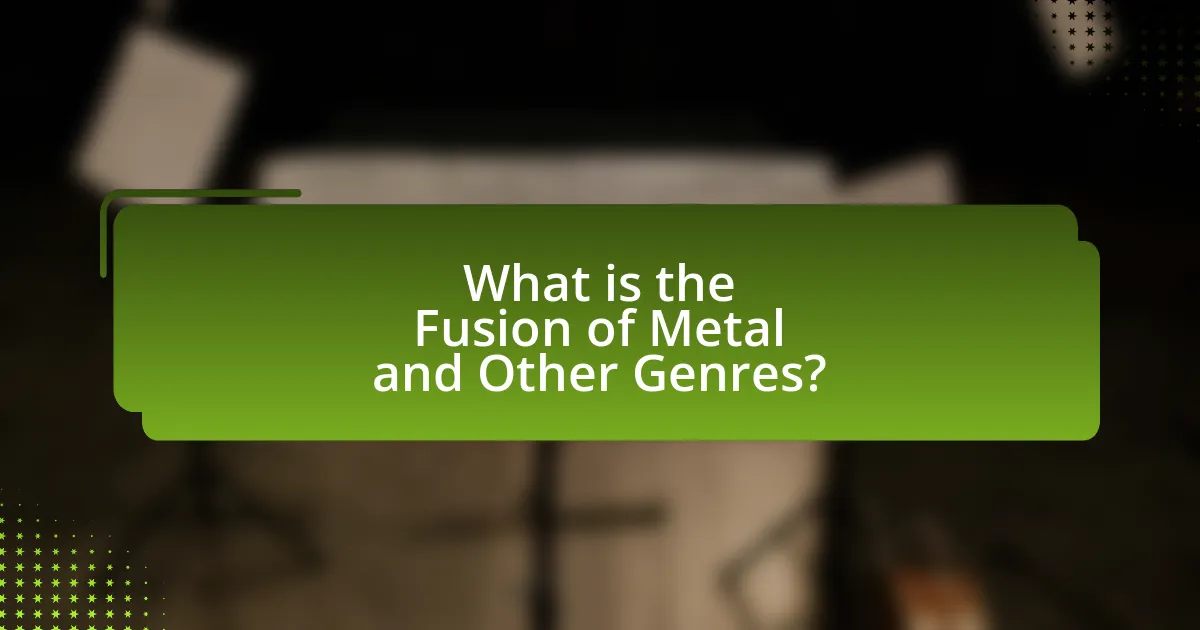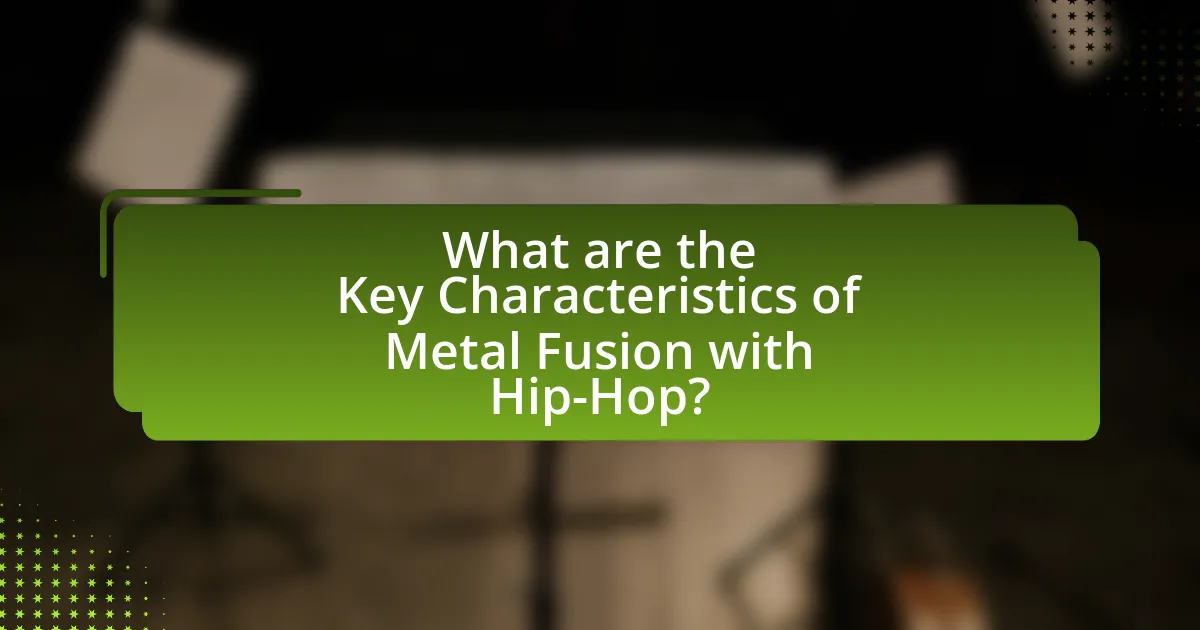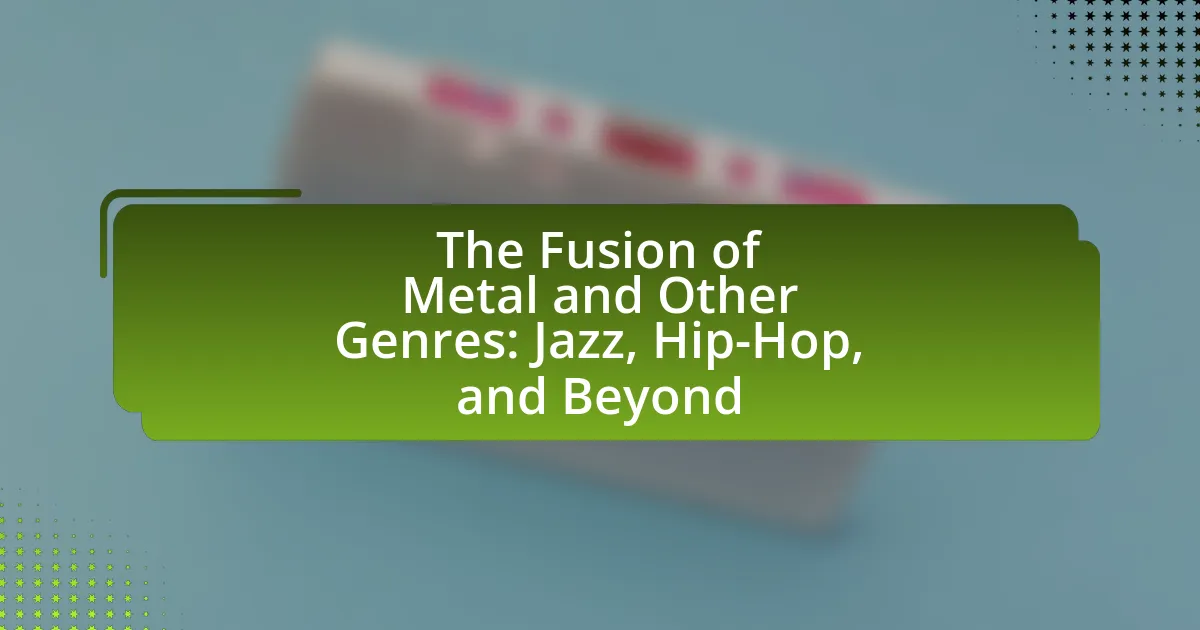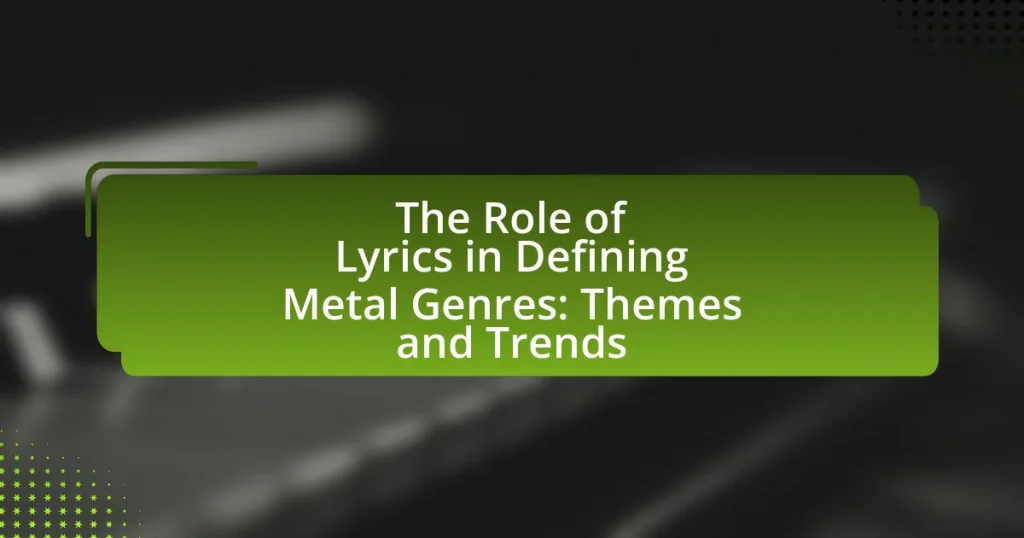The article explores the fusion of metal music with other genres, particularly jazz and hip-hop, highlighting how these combinations create innovative hybrid sounds. It examines the historical evolution of these fusions, significant collaborations between artists, and the cultural impacts that arise from blending distinct musical styles. Key characteristics of metal fusion with jazz and hip-hop are discussed, including complex rhythms, improvisation, and thematic diversity in lyrics. The article also addresses future trends in genre fusion, emphasizing the role of technology and emerging genres that may further influence metal music.

What is the Fusion of Metal and Other Genres?
The fusion of metal and other genres refers to the blending of heavy metal music with various musical styles, creating hybrid genres that incorporate elements from both. This fusion can include combinations with jazz, hip-hop, classical, and electronic music, resulting in diverse sounds and innovative compositions. For example, the album “Jazz Metal” by the band Panzerballett showcases how jazz improvisation can coexist with metal’s aggressive riffs, while artists like Rage Against the Machine merge metal with hip-hop rhythms and lyrical styles. Such fusions expand the boundaries of metal, attracting a wider audience and influencing the evolution of contemporary music.
How has the fusion of metal with jazz and hip-hop evolved over time?
The fusion of metal with jazz and hip-hop has evolved significantly since the late 20th century, characterized by innovative collaborations and genre-blending techniques. In the 1980s, bands like Living Colour and Faith No More began incorporating jazz elements into their metal sound, utilizing complex rhythms and improvisation. The 1990s saw the emergence of nu-metal, where artists like Korn and Linkin Park integrated hip-hop influences, featuring rapped verses and DJ techniques alongside heavy guitar riffs.
By the 2000s, artists such as Meshuggah and The Dillinger Escape Plan further pushed boundaries by blending progressive metal with jazz fusion, showcasing intricate time signatures and polyrhythms. Concurrently, hip-hop artists like Kid Rock and Lil Wayne began collaborating with metal musicians, creating cross-genre tracks that appealed to diverse audiences.
Recent years have witnessed a resurgence of interest in this fusion, with bands like Animals as Leaders and artists like Anderson .Paak experimenting with metal, jazz, and hip-hop elements, reflecting a growing acceptance and appreciation for genre-blending in contemporary music. This evolution highlights the dynamic nature of musical genres and their ability to influence and reshape one another over time.
What historical events influenced the blending of these genres?
The blending of metal with genres like jazz and hip-hop was significantly influenced by the cultural and social movements of the late 20th century. The rise of counterculture in the 1960s and 1970s, characterized by a rejection of mainstream values, encouraged experimentation in music, leading artists to fuse different styles. For instance, the emergence of jazz fusion in the 1970s, which combined jazz improvisation with rock elements, paved the way for metal musicians to explore complex rhythms and harmonies. Additionally, the hip-hop movement of the 1980s and 1990s, which emphasized sampling and cross-genre collaboration, allowed metal artists to incorporate rap elements into their music, exemplified by collaborations like Run-D.M.C. and Aerosmith’s “Walk This Way.” These historical events created an environment ripe for genre blending, resulting in innovative sounds that challenged traditional musical boundaries.
How have artists from both genres collaborated?
Artists from metal and genres like jazz and hip-hop have collaborated through various projects that blend their distinct musical styles. For instance, the collaboration between metal band Metallica and jazz musician Michael Brecker on the track “Jazz Metal” showcases how elements of jazz improvisation can enhance metal’s complexity. Additionally, hip-hop artists such as Kid Rock and Lil Wayne have incorporated metal influences in their music, collaborating with metal musicians to create hybrid tracks that appeal to fans of both genres. These collaborations often result in innovative sounds, as seen in the album “Collision Course,” where Jay-Z and Linkin Park fused hip-hop and metal, demonstrating the successful merging of their musical elements.
Why is the fusion of metal with other genres significant?
The fusion of metal with other genres is significant because it expands the musical landscape, allowing for innovative sounds and diverse expressions. This blending creates new subgenres, such as metalcore and jazz metal, which attract wider audiences and foster collaboration among artists. For instance, the collaboration between metal bands and hip-hop artists has led to commercially successful projects, like the album “Collision Course” by Jay-Z and Linkin Park, which debuted at number one on the Billboard 200. Such fusions not only enhance creativity but also challenge traditional genre boundaries, reflecting the evolving nature of music in contemporary culture.
What cultural impacts have emerged from these musical fusions?
Musical fusions between metal and genres like jazz and hip-hop have led to significant cultural impacts, including the broadening of musical boundaries and the promotion of cross-genre collaboration. These fusions have facilitated the emergence of new subcultures, such as nu-metal, which blends elements of hip-hop with metal, attracting diverse audiences and fostering inclusivity. For instance, bands like Rage Against the Machine and Linkin Park have successfully integrated rap and metal, influencing a generation of musicians and listeners. Additionally, the collaboration between metal artists and jazz musicians has introduced complex rhythms and improvisation into metal, enriching its artistic expression and appealing to a wider demographic. This blending of styles has not only diversified the music scene but also encouraged cultural exchange and dialogue among different musical communities.
How does this fusion challenge traditional genre boundaries?
The fusion of metal with genres like jazz and hip-hop challenges traditional genre boundaries by blending distinct musical elements, creating innovative soundscapes that defy categorization. This cross-pollination allows for the incorporation of jazz’s improvisational techniques and hip-hop’s rhythmic complexity into metal’s aggressive framework, resulting in a hybrid that attracts diverse audiences. For instance, artists like Meshuggah and Animals as Leaders have successfully integrated complex jazz harmonies and polyrhythms into their metal compositions, demonstrating how these fusions can expand the expressive possibilities of both genres.

What are the Key Characteristics of Metal Fusion with Jazz?
The key characteristics of metal fusion with jazz include complex rhythms, improvisation, and a blend of heavy instrumentation with jazz harmonies. Metal fusion often incorporates intricate time signatures and polyrhythms typical of jazz, allowing for dynamic and unpredictable musical structures. Additionally, musicians frequently engage in improvisational solos, a hallmark of jazz, while maintaining the aggressive sound and energy of metal. This genre fusion also features the use of jazz scales and modes, enriching the harmonic palette and creating a unique sound that distinguishes it from traditional metal or jazz alone. Notable examples include the works of bands like Cynic and Animals as Leaders, which showcase these characteristics effectively.
How do jazz elements enhance metal music?
Jazz elements enhance metal music by introducing complex rhythms, improvisation, and sophisticated harmonies. The incorporation of syncopated rhythms and polyrhythms from jazz allows metal musicians to create intricate and dynamic compositions that elevate the genre’s technicality. Additionally, jazz’s emphasis on improvisation encourages metal artists to explore spontaneous creativity during performances, leading to unique and varied live experiences. The use of extended chord progressions and modal interchange from jazz enriches the harmonic palette of metal, resulting in a more diverse sound. This fusion is exemplified in works by bands like Cynic and Animals as Leaders, who blend jazz techniques with metal structures, showcasing the successful integration of these genres.
What specific jazz techniques are commonly used in metal?
Specific jazz techniques commonly used in metal include complex chord progressions, polyrhythms, and improvisation. Complex chord progressions, often utilizing extended chords and altered scales, enhance harmonic richness in metal compositions. Polyrhythms, which involve layering contrasting rhythms, create intricate rhythmic textures that are prevalent in both jazz and metal. Additionally, improvisation, a hallmark of jazz, is frequently incorporated in metal solos, allowing musicians to express creativity and technical skill. These techniques contribute to the unique sound that characterizes the fusion of jazz and metal genres.
How do improvisation and rhythm play a role in this fusion?
Improvisation and rhythm are essential components in the fusion of metal with genres like jazz and hip-hop. Improvisation allows musicians to express creativity and spontaneity, leading to unique performances that blend complex metal riffs with jazz’s fluidity or hip-hop’s rhythmic patterns. For instance, jazz-influenced metal bands often incorporate extended solos and unpredictable changes in tempo, showcasing the improvisational skills of the musicians. Rhythm, on the other hand, serves as the backbone of this fusion, with metal’s aggressive beats merging with the syncopated rhythms of hip-hop or the swing feel of jazz, creating a dynamic interplay that enhances the overall sound. This rhythmic complexity is evident in works by artists like Meshuggah, who utilize polyrhythms, and in collaborations between metal and hip-hop artists, where the rhythmic foundation drives the fusion forward.
What notable examples exist of metal and jazz fusion?
Notable examples of metal and jazz fusion include the works of bands like Cynic and Atheist, which blend progressive metal with jazz elements. Cynic’s album “Focus,” released in 1993, incorporates intricate jazz-inspired guitar work and complex time signatures, showcasing a seamless integration of genres. Atheist’s “Piece of Time,” released in 1990, features jazz-influenced rhythms and improvisational solos, further exemplifying this fusion. Additionally, the band Panzerballett is known for its unique approach, combining heavy metal with jazz improvisation, particularly in their album “Stoner Metal,” which highlights the versatility of both genres.
Which artists are pioneers in this genre fusion?
Pioneers in the fusion of metal with other genres include artists like Faith No More, who blended metal with funk and hip-hop, and Mr. Bungle, known for their eclectic mix of metal, jazz, and avant-garde influences. Additionally, bands like Rage Against the Machine have combined metal with hip-hop, creating a unique sound that has influenced many. These artists are recognized for their innovative approaches, which have significantly shaped the landscape of genre fusion in music.
What albums or tracks exemplify this blend effectively?
Albums and tracks that exemplify the fusion of metal with other genres include “The Blackening” by Machine Head, which incorporates elements of thrash metal and progressive rock, and “Korn” by Korn, blending nu-metal with hip-hop influences. Additionally, “Jazz Metal” by the band Panzerballett showcases a unique combination of jazz improvisation and metal instrumentation. These examples highlight the successful integration of diverse musical styles, demonstrating the versatility and creativity within the metal genre.

What are the Key Characteristics of Metal Fusion with Hip-Hop?
The key characteristics of metal fusion with hip-hop include the blending of aggressive guitar riffs and heavy drumming typical of metal with rhythmic vocal delivery and sampling found in hip-hop. This fusion often features collaborations between metal musicians and hip-hop artists, creating a unique sound that incorporates elements such as breakdowns, turntablism, and lyrical themes that address social issues, personal struggles, or rebellion. Notable examples include the collaboration between bands like Rage Against the Machine and artists like Cypress Hill, which exemplify this genre’s ability to merge distinct musical styles while maintaining the intensity and energy of both genres.
How does hip-hop influence the sound and style of metal music?
Hip-hop influences the sound and style of metal music through rhythmic complexity, lyrical delivery, and production techniques. The incorporation of hip-hop’s syncopated beats and varied tempos enhances the dynamic range of metal, allowing for more intricate drumming patterns and bass lines. Additionally, metal artists often adopt hip-hop’s aggressive vocal styles, including rapping and spoken word, which can be heard in tracks by bands like Linkin Park and Rage Against the Machine. The blending of production techniques, such as sampling and electronic elements, further merges the genres, exemplified by collaborations between artists like Kid Rock and metal bands. This fusion not only broadens the appeal of metal but also creates innovative soundscapes that challenge traditional genre boundaries.
What lyrical themes are commonly explored in this fusion?
Lyrical themes commonly explored in the fusion of metal with genres like jazz and hip-hop include existentialism, social issues, and personal struggles. Existentialism often reflects on the meaning of life and individual purpose, as seen in metal’s introspective lyrics. Social issues are frequently addressed, tackling topics such as inequality, violence, and political unrest, which resonate in both metal and hip-hop. Personal struggles, including mental health and identity crises, are also prevalent, allowing artists to connect deeply with their audience through shared experiences. This thematic diversity enhances the emotional depth and complexity of the music, making it relatable across different listener demographics.
How do beats and sampling techniques integrate with metal?
Beats and sampling techniques integrate with metal by introducing rhythmic complexity and diverse sonic textures that enhance the genre’s traditional sound. Metal bands often incorporate electronic beats and samples to create a fusion that broadens their musical palette, as seen in the works of bands like Fear Factory and Linkin Park, who blend aggressive guitar riffs with programmed drums and sampled elements. This integration allows for innovative compositions that appeal to a wider audience, demonstrating the versatility of metal when combined with elements from genres like hip-hop and electronic music.
What notable collaborations exist between metal and hip-hop artists?
Notable collaborations between metal and hip-hop artists include the track “Judgment Night” featuring Biohazard and Onyx, which was part of the soundtrack for the 1993 film of the same name. Another significant collaboration is “Walk This Way” by Aerosmith and Run-D.M.C., which helped bridge the gap between the two genres in 1986. Additionally, the song “Freak on a Leash” by Korn features a remix with hip-hop artist Lil Wayne, showcasing the blending of styles. These collaborations highlight the successful fusion of metal and hip-hop, demonstrating their cultural impact and influence on music.
Which tracks have gained significant popularity in this genre fusion?
Tracks that have gained significant popularity in the fusion of metal with other genres include “Judith” by A Perfect Circle, which blends alternative metal with progressive rock elements, and “Bring Me to Life” by Evanescence, merging metal with gothic rock and orchestral influences. Additionally, “Duality” by Slipknot showcases a mix of nu-metal and heavy metal with hip-hop influences, while “Rockstar” by Post Malone features a blend of hip-hop and rock, appealing to metal fans. These tracks exemplify the successful integration of metal with diverse musical styles, contributing to their widespread acclaim and popularity.
How have these collaborations impacted both genres?
Collaborations between metal and genres like jazz and hip-hop have significantly enriched both musical styles by introducing new techniques and audiences. For instance, the incorporation of jazz elements into metal has led to complex time signatures and improvisational solos, as seen in the works of bands like Cynic and Animals as Leaders. Similarly, hip-hop collaborations with metal artists, such as the partnership between Rage Against the Machine and various hip-hop artists, have created a fusion that appeals to diverse listeners and has expanded the reach of both genres. This blending has not only diversified the sound but also fostered a cultural exchange that enhances creativity and innovation within the music industry.
What are the Future Trends in Metal Fusion with Other Genres?
Future trends in metal fusion with other genres include increased collaboration with electronic music, hip-hop, and world music, leading to innovative soundscapes. The integration of electronic elements, such as synthesizers and digital production techniques, is becoming more prevalent, as seen in the works of bands like Bring Me The Horizon, who blend metalcore with electronic influences. Additionally, collaborations with hip-hop artists, exemplified by the partnership between metal bands and rappers, are gaining traction, creating a cross-genre appeal that attracts diverse audiences. This trend is supported by the growing popularity of genre-blending festivals and playlists, which highlight the demand for hybrid musical experiences.
How might technology influence the evolution of these fusions?
Technology significantly influences the evolution of fusions between metal and other genres like jazz and hip-hop by enabling innovative sound production and collaboration. Digital audio workstations (DAWs) allow musicians to blend diverse styles seamlessly, facilitating the integration of complex rhythms and harmonies characteristic of jazz with the aggressive elements of metal. Additionally, advancements in music distribution platforms enable artists to reach wider audiences, promoting cross-genre collaborations. For instance, the rise of online platforms has led to successful projects like the collaboration between metal band Animals as Leaders and jazz musicians, showcasing how technology fosters genre-blending creativity.
What emerging genres could further blend with metal in the future?
Emerging genres that could further blend with metal in the future include electronic music, progressive rock, and trap. Electronic music, particularly subgenres like dubstep and synthwave, has already shown compatibility with metal through collaborations and remixes, enhancing the intensity and complexity of sound. Progressive rock’s intricate compositions and experimental nature align well with metal’s technical prowess, allowing for innovative fusions. Additionally, trap’s rhythmic elements and lyrical styles have begun to influence metal, as seen in the works of artists who incorporate hip-hop beats and flows into their metal tracks, creating a unique hybrid sound.
What are Best Practices for Exploring Metal Fusion with Other Genres?
Best practices for exploring metal fusion with other genres include maintaining a balance between the distinct elements of metal and the characteristics of the other genre, ensuring that both styles complement each other rather than clash. Collaborating with artists from the other genre can provide authentic insights and techniques, enhancing the fusion’s authenticity. Additionally, experimenting with instrumentation and song structures can create innovative soundscapes that highlight the strengths of both genres. For instance, the incorporation of jazz improvisation techniques in metal compositions can lead to unique rhythmic and melodic developments. Historical examples, such as the collaboration between metal bands and hip-hop artists, demonstrate successful genre blending, showcasing how diverse influences can lead to groundbreaking music.
How can musicians effectively incorporate elements from other genres into metal?
Musicians can effectively incorporate elements from other genres into metal by blending distinct musical techniques, rhythms, and instrumentation characteristic of those genres. For instance, integrating jazz elements can involve using complex chord progressions and improvisation, while hip-hop influences can be introduced through rhythmic vocal delivery and sampling. Historical examples include the band “Pantera,” which incorporated groove metal with elements of Southern rock, and “Metallica,” which has utilized orchestral arrangements in their music. These integrations not only expand the sonic palette of metal but also attract diverse audiences, demonstrating the genre’s versatility and adaptability.
What resources are available for learning about genre fusion techniques?
Resources for learning about genre fusion techniques include books, online courses, and academic articles. Notable books such as “The Rest Is Noise” by Alex Ross provide insights into the blending of genres, while online platforms like Coursera and MasterClass offer courses on music theory and genre fusion. Additionally, academic journals like the Journal of Popular Music Studies publish research on genre fusion, highlighting case studies and theoretical frameworks. These resources collectively enhance understanding of how different musical styles can be combined effectively.



